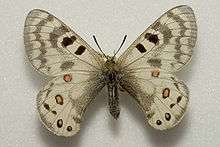Parnassius delphius
Parnassius delphius, the banded Apollo, is a high-altitude butterfly which is found in Central Asia. It is a member of the genus Parnassius of the swallowtail family, Papilionidae.
| Banded Apollo | |
|---|---|
 | |
| Parnassius delphius maximinus, male from Kyrgyzstan | |
| Scientific classification | |
| Kingdom: | Animalia |
| Phylum: | Arthropoda |
| Class: | Insecta |
| Order: | Lepidoptera |
| Family: | Papilionidae |
| Genus: | Parnassius |
| Species: | P. delphius |
| Binomial name | |
| Parnassius delphius Eversmann, 1843 | |
Description
Note: The wing pattern in Parnassius species is inconsistent and the very many subspecies and forms make identification problematic and uncertain. Structural characters derived from the genitalia, wing venation, sphragis and foretibial epiphysis are more, but not entirely reliable. The description given here is a guide only. For an identification key see Ackery P.R. (1975).[1]
Discal markings dull, submarginal band of forewing distinct, hindmarginal spot absent as a rule; ocelli of hindwing bright carmine, hindmarginal spots black, blackish hindmarginal area broad, two bluish-black anal spots, a faint submarginal and narrow marginal band.[2]
Range
Northern Pakistan, Afghanistan, Tajikistan, Kyrgyzstan, Uzbekistan and Kazakhstan.
Status
Widely distributed. Locally common, generally rare. Not known to be threatened. Requires further research. Protected by law in India. Featured in erstwhile USSR Red Data Book as vulnerable.

Subspecies
There are up to 44 subspecies.[3]
 Parnassius delphius infernalis, male from the Alai Mountains
Parnassius delphius infernalis, male from the Alai Mountains
References
- Ackery P.R. (1975) A guide to the genera and species of Parnassiinae (Lepidoptera:Papilionidae). Bull. Br. Mus. nat. Hist. (Ent.) 31, 4 pdf
- Stichel in Seitz, 1906 (Parnassius). Die Groß-Schmetterlinge der Erde. Die Groß-Schmetterlinge des palaearktischen Faunengebietes. Die palaearktischen Tagfalter, Stuttgart.
- Funet
- Collins, N. Mark; Morris, Michael G. (1985). Threatened Swallowtail Butterflies of the World: The IUCN Red Data Book. Gland & Cambridge: IUCN. ISBN 978-2-88032-603-6 – via Biodiversity Heritage Library.
- Evans, W.H. (1932). The Identification of Indian Butterflies (2nd ed.). Mumbai, India: Bombay Natural History Society.
- Haribal, Meena (1992). The Butterflies of Sikkim Himalaya and Their Natural History. Gangtok, Sikkim, India: Sikkim Nature Conservation Foundation.
- Kunte, Krushnamegh (2000). Butterflies of Peninsular India. India, A Lifescape. Hyderabad, India: Universities Press. ISBN 978-8173713545.
- Wynter-Blyth, Mark Alexander (1957). Butterflies of the Indian Region. Bombay, India: Bombay Natural History Society. ISBN 978-8170192329.
- Sakai S., Inaoka S., Toshiaki A., Yamaguchi S., Watanabe Y., (2002) The Parnassiology. The Parnassius Butterflies, A Study in Evolution, Kodansha, Japan.
- Weiss J.-C., (1992) Parnassiinae of the World - Part 2, Sciences Nat, Venette, France.